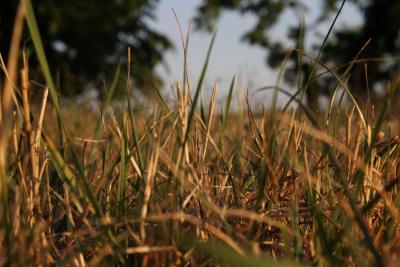A Golden Landscape
If a lawn can suffer no reduced quality if it gets only 80% of the water it wants, then what happens if it gets even less? Not much, really. Many turf grasses will enter a dormant cycle when challenged by water stress. The grass turns a golden color and takes a nap until the fall rain returns. As a bonus, the lawn doesn’t grow much, so the mower can also stay in the garage. Consider letting your lawn go dormant this summer, by only watering monthly during peak drought stress (June, July, August, September).
A lawn can provide a safe, soft surface for children to play on. Turf grass provides many benefits. It can help filter pollution that might otherwise run off your lawn and into our streams and rivers. Landscapes help cool your home not only by providing shade, but by evaporating or transpiring water, and lawns can transpire a lot of water. When water turns from liquid to gas, it takes heat away with it. It’s like a natural air conditioner.
It is turf’s ability to transpire so much water that also makes keeping a green lawn a decision that isn’t always ecologically green. Homeowners who typically irrigate their lawns apply, on average, about twice as much water as their lawns need. What’s more, scientists at OSU’s Turf Research Farm have found that lawns don’t need as much water as they can use, and that reducing irrigation to provide only about 80% of a lawn’s water demand does not affect turf quality at all.
The hottest and driest part of the year runs from the end of July through the month of August, and plant water needs are high during this time. Long daylight hours, warm temperatures, and wind increase both soil evaporation and the amount of water that plants use. Most un-irrigated lawns in western Oregon become dormant and turn a golden color. The lawn does not die; it just waits for the fall rains. This is a great option because a lawn that grows less or slower doesn’t have to be mowed as often. Consider saving water, money, energy, and your time by letting your lawn go dormant this summer.
Want to take the next step? Explore alternatives to turf grasses. Consider using a seed mixture that contains turf grass for green in the spring but also contains flowers and herbs that respond well to mowing and remain green with very little irrigation throughout the summer. They also don’t have to be mowed very often or fertilized. Another turf alternative is microclover. Microclover has very small leaves, can grow among turf grass and, as a legume, can actually add nitrogen to your soil and help eliminate the need for any additional fertilizer. Also consider using native, water efficient plants to reduce the amount of grass.
Check out other Outdoor Water Conservation tips HERE.
Read about lawns on OSU's website HERE.
For more information, email Public Works or call 541-766-6916.
